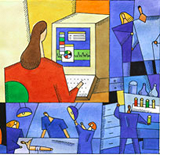 Months after it began, the fungal meningitis outbreak continues, with the CDC recently reporting a total of 620 cases and 39 deaths so far in 19 states involved. I have been watching closely how one IDN that has received many of affected patients has used its EMR technology to better manage the outbreak. (The system just achieved Stage 6 EMR adoption recognition from HIMSS, putting it in the top 7% of hospitals in the U.S.) Real-time visibility of data on the care and treatment of the affected patients, coupled with the ability to comprehensively embed new treatment directives from the CDC, have drastically improved this IDN’s ability to care for meningitis patients.
Months after it began, the fungal meningitis outbreak continues, with the CDC recently reporting a total of 620 cases and 39 deaths so far in 19 states involved. I have been watching closely how one IDN that has received many of affected patients has used its EMR technology to better manage the outbreak. (The system just achieved Stage 6 EMR adoption recognition from HIMSS, putting it in the top 7% of hospitals in the U.S.) Real-time visibility of data on the care and treatment of the affected patients, coupled with the ability to comprehensively embed new treatment directives from the CDC, have drastically improved this IDN’s ability to care for meningitis patients.
This is one of those moments that I take as an affirmation that those of us working to embed technology into improvement efforts are doing the right work. The work is daunting no doubt, given the data cleansing and change management required, but if it truly improves our ability to deliver care, it’s worth every effort.
That said, the meningitis outbreak and its aftermath have also helped me crystallize the call to action that I believe we need to embrace in healthcare supply chain. What if the fungus that tainted the steroid was in/on a stent, catheter or some other supply item? We would not know who received the tainted product; we couldn’t avoid further exposure because we wouldn’t know where the tainted product is in the supply chain; and we likely would not have ready access to viable alternatives.
If Ford knows the lot and serial number of a bolt in the left front quarter panel on my Taurus, and Kroger can know how often I buy eggs, and pharmaceuticals can be tracked and traced to the patient, the technology and wherewithal clearly exist. Leadership is all that’s lacking to get this to done.
I promised in my last post to continue to share successful means to lead the change we discuss (the “how” to follow the “should”). So how about data? We complain on the state of it, acknowledge that it is at the core of many of our inefficiencies, but what is there to be done about it?
First, let me be clear, we do assist clients with data cleansing, but only because it is necessary. I do not believe that hiring a third-party data-cleansing firm is the answer. Nor do I believe that inserting a data translation layer in the transaction stream is the right answer. I advocate for the old, “Do it right the first time” approach.
Specifically, I believe that each provider, as the buyer in the trade relationship, has a responsibility to patients to accurately track and trace supplies. Granted, do we need to know where each 4-by-4 gauze goes? No, not until it enters the OR; then we need processes to be sure it is accounted for properly. But we do need to ensure that products that may one day be recalled or otherwise need to be traced are accurately documented to a patient.
Clean data is a byproduct; effective track-and-trace processes are the means. GS1 and GTIN adoption are cornerstones of sound processes. The sheer magnitude of the problem is the barrier. But how do you “eat the elephant?” One bite at a time. This old adage may be clichéd, but fits the situation perfectly, in my opinion. You don’t eat the elephant by talking about how big it is or complaining about its toughness.
These track-and-trace processes will require significant change in current practice and will involve caregivers. It is the supply chain practitioner’s responsibility to find the most practical and efficacious means. RFID, bar coding, cabinets, open systems – all are available in multiple configurations. But the key to success, regardless of the technology, is the engagement of the clinical stakeholders. They will need to embrace the change and champion its implementation.
The “how” here sounds simple, but requires a great deal of leadership finesse. The underlying message is the same; it is about the patients – patient safety to be exact. It’s not about capturing more revenue and it’s not about managing inventories – those will happen and will provide tangential measurable benefit – but the real reason must be because it is the right thing to do for the patient. This message will resonate with the clinicians. Who could help but get impassioned by such a call to action?


Pingback: Patient safety – lessons from other industries - VUEMED